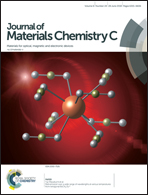High thermochromic performance of Fe/Mg co-doped VO2 thin films for smart window applications
Abstract
In the field of energy-efficient smart windows, vanadium dioxide (VO2) is a promising material due to its reversible metal–insulator transition. However, the development of VO2-based smart windows has been restricted by several drawbacks in performance, including high phase transition temperature (TC), low luminous transmittance (Tlum), insufficient solar energy modulation ability (ΔTsol) and unpopular color. In this paper, Fe/Mg co-doping is proposed for the first time to improve the thermochromic performance of VO2 films. Interestingly, the Fe/Mg co-doped films can exhibit outstanding thermochromic performance with a balanced solar regulation efficiency of 12.8%, suitable luminous transmittance up to 42.1%, and low phase transition temperature around 38.2 °C, which is very promising for practical applications. In addition, the color of films is modified to increase their brightness and lighten the brown color. Different from previous work on co-doped VO2 focusing on W6+ and low-valence (<4+) elements, Fe3+/Mg2+ co-doping is found to have the synergistic combination of the advantages of single doping with Fe and Mg by getting rid of the neutralization between charge carriers e− and h+. Such a feature is especially desired for optimizing the thermochromic performance with co-doping methods. This study provides a new solution for improving the optical properties of VO2 films for smart window applications.



 Please wait while we load your content...
Please wait while we load your content...